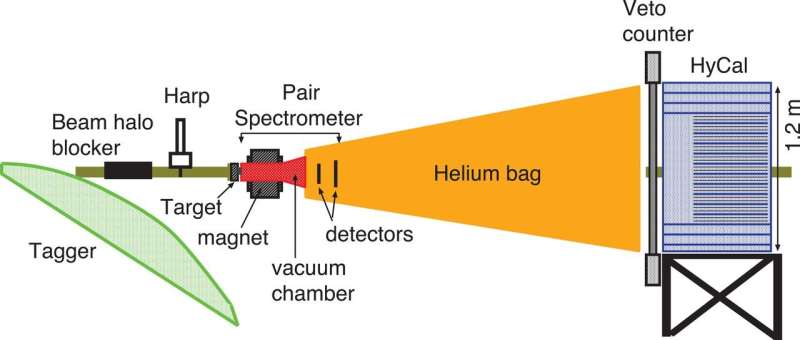May 1, 2020 report
Improved Primakoff-type experiment gives improved accuracy of pion measurement

A large international team of researchers has improved upon Primakoff-type experiments to give an improved accuracy of pion measurement. In their paper published in the journal Science, the group gives an overview of their objectives and outline the experiments they conducted to achieve higher accuracy when measuring the decay of a pion into two photons. Harvey Meyer, with the University of Mainz provides a timeline of the history of quantum chromodynamics theory and also gives an overview of the work done by the researchers in this new effort, in the same journal issue.
Theory suggests that Pi mesons, more commonly called pions, are hadrons consisting of a quark and an antiquark (which is why they are sometimes also called neutral mesons). Theory also suggests that single pions decay to pairs of photons, and they do so very quickly because they are unstable—on the order of 80 attoseconds. As with most theories, scientists would like to conduct experiments that prove such theories are correct—at least to a certain degree of accuracy. Prior efforts to test pions decaying to photons generally have followed one of three methods, the direct or collider methods—or the Primakoff method. In this new effort, the researchers have used the Primakoff method, but have added improvements to increase its accuracy.
The work by the team involved an experimental setup the team called PrimEx-II—it featured a tagged photon beam facility with a unique calorimeter (an improvement over the traditional calorimeter used in the Primakoff method), a beam halo blocker and a harp. Tagged photons were introduced to a magnet that deflected the charged particles. From there the decay photons traveled through a vacuum chamber and a helium bag where they were detected and counted by a veto counter and HyCal calorimeter. The team also increased the accepted energy interval of the tagged photons from that normally used in the Primakoff method to further improve accuracy.
In running the experiment, the researchers achieved a total uncertainty of 2.8 percent—half that of prior efforts. It was also consistent with predictions made originally by quantum chromodynamics theory, but was less so when compared with other theories.
More information: I. Larin et al. Precision measurement of the neutral pion lifetime, Science (2020). DOI: 10.1126/science.aay6641
Journal information: Science
© 2020 Science X Network




















